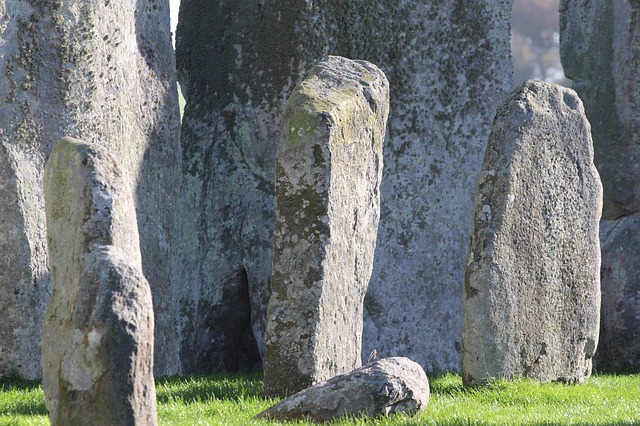Joggle
Contents |
[edit] Introduction
The Penguin Dictionary of Architecture (third edition) was published in 1980. It was created for Penguin Reference and compiled by John Fleming, Hugh Honour and Nikolaus Pevsner.
It defines joggle or joggling as a: ‘Masons’ terms for joining two stones in such a way as to prevent them from slipping or sliding by means of a notch in one and a corresponding projection in the other. It is often seen exposed on the face of a flat arch. If the joggle is concealed, it is called a "secret joggle"'.
[edit] History
As an old construction technique, joggle joints were used in the construction of Stonehenge along with the mortise and tenon joint construction used for some of the lintels.
Joggle joints were commonly used for load bearing masonry to prevent vertical butt joints from moving, horizontal stones from sliding and other stones from moving laterally. The joints would sometimes be frogged with a point or chisel for added stability.
[edit] Basic joggling characteristics
Joggle joints strengthen and stabilise structures and that respect, they serve a similar function to tongue and groove joints which are made with a tongue (male) ridge projection on one edge and a matching groove (female) slot recession on the other edge. The tongue of one piece fits into the groove of the corresponding piece to form a strong, flush joint.
Unlike tongue and groove constructions - which are generally strong and stable - a joggle joint can sometimes weaken. This happens because the formation of the joggle projection (sometimes referred to as a shoulder) can cause stress in the stone. This stress can eventually cause the joggle joint to break. To preserve the joint, it is important to make sure the weight is evenly distributed. This will create a cohesive lock that should be able to support the force applied to the joint adequately.
[edit] Other types of joggles
The function of a joggle as applied in masonry terms has been adopted in other aspects of construction and related terminology. There are table or bed joggles, tongue and groove joggles and slate or metal joggled joints.
[edit] Joggle bending
Joggle bending is an expression used to describe an offset bend where two opposite bends with equal angles are formed in a single action. This configuration creates a bend profile and an offset between the unbent face and the resulting flange. The joint that is formed should be thin and smooth.
[edit] Sheet metal joggles
The premise of joggle joints is also used in sheet metal, where the joggle joint is an offset or notch that is created at the place where stringers and formers meet. It is used to create space for a sheet or another mating part. The joint provides a clean connection in the splice.
Joggle joint coping is sometimes used in types of roofing. Joggles can also be used for gutters.
[edit] Related articles on Designing Buildings Wiki
Featured articles and news
RTPI leader to become new CIOB Chief Executive Officer
Dr Victoria Hills MRTPI, FICE to take over after Caroline Gumble’s departure.
Social and affordable housing, a long term plan for delivery
The “Delivering a Decade of Renewal for Social and Affordable Housing” strategy sets out future path.
A change to adoptive architecture
Effects of global weather warming on architectural detailing, material choice and human interaction.
The proposed publicly owned and backed subsidiary of Homes England, to facilitate new homes.
How big is the problem and what can we do to mitigate the effects?
Overheating guidance and tools for building designers
A number of cool guides to help with the heat.
The UK's Modern Industrial Strategy: A 10 year plan
Previous consultation criticism, current key elements and general support with some persisting reservations.
Building Safety Regulator reforms
New roles, new staff and a new fast track service pave the way for a single construction regulator.
Architectural Technologist CPDs and Communications
CIAT CPD… and how you can do it!
Cooling centres and cool spaces
Managing extreme heat in cities by directing the public to places for heat stress relief and water sources.
Winter gardens: A brief history and warm variations
Extending the season with glass in different forms and terms.
Restoring Great Yarmouth's Winter Gardens
Transforming one of the least sustainable constructions imaginable.
Construction Skills Mission Board launch sector drive
Newly formed government and industry collaboration set strategy for recruiting an additional 100,000 construction workers a year.
New Architects Code comes into effect in September 2025
ARB Architects Code of Conduct and Practice available with ongoing consultation regarding guidance.
Welsh Skills Body (Medr) launches ambitious plan
The new skills body brings together funding and regulation of tertiary education and research for the devolved nation.
Paul Gandy FCIOB announced as next CIOB President
Former Tilbury Douglas CEO takes helm.
UK Infrastructure: A 10 Year Strategy. In brief with reactions
With the National Infrastructure and Service Transformation Authority (NISTA).























